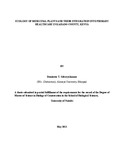Ecology of medicinal plants and their integration into primary healthcare in Kajiado County, Kenya

View/
Date
2013Author
Gebreyohannes, Demissew T
Type
ThesisLanguage
enMetadata
Show full item recordAbstract
The study was conducted with aim of assessing the composition, distribution, abundance and the
community structure of local medicinal plants; and determining the modes of exploitation and
contribution of these plants in primary health care and livelihoods of rural communities in
Marble Quarry (KMQ), Mile 46 and Oltepesi at Central Kajiado, Kenya. Data were obtained
using semi-structured forms to record topics related to the medicinal use of specific plants and
through vegetation sampling in the field. The medicinal use value of plant species in the research
sites did not reveal significance differences (df=2, F= 0.956, P=0.388, a=0.05). Relative
abundances of species in the three research sites were highest . for Balanites aegyptiaca (36.92%)
in KMQ, Commiphora africana (28.41 %) and Balanites aegyptiaca (27.27%) followed by
Acacia drepanolobium (21.6%) in Mile 46, while in Oltepesi, Balanites aegyptiaca (39.4%) was
the dominant species. This indicated that the area was dominated by only a few medicinal plant
species. At Mile 46 and KMQ all the species had a contagious distribution while in Oltepesi, one
species Albizia anthelmintica showed a regular distribution.
In Oltepesi research area, lower species diversity and evenness were recorded as compared to the
other two sites, though no significant differences (df= 2, P=O. 259, a = 0.05) was noted between
the sites. The species diversity in the area was of homogenous type. Oltepesi had the highest beta
diversity (B) (2.52) followed equally by KMQ and Mile46 (0.846).
The medicinal use value index of a plant species was highly correlated with the sites and this
indicated that the plant species had great contribution to primary health care and livelihood of the
society. The main threats of medicinal plants in the area were deforestation, drought, lack of
awareness, urbanization, ignorance and expansion of human settlements in the study areas but
didn't reveal significant difference statistically (df=2, F=O.564, P=O.571 and a=O.05). An
integrated conservation strategy is required in the area to conserve many of the medicinal
species.
Citation
Demissew T. Gebreyohannes (2013). Ecology Of Medicinal Plants And Their Integration Into Primary Healthcare In Kajiado County, Kenya. Master of Science in Biology of ConservationPublisher
University of Nairobi School of Biological Sciences
